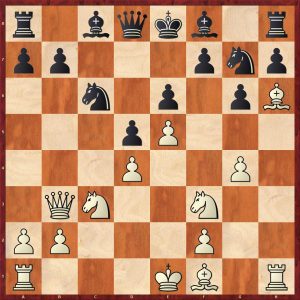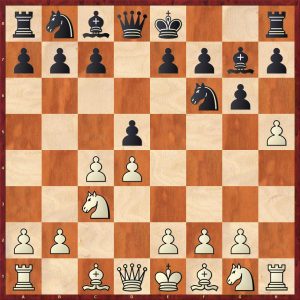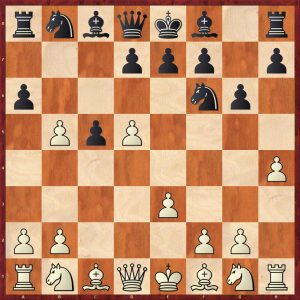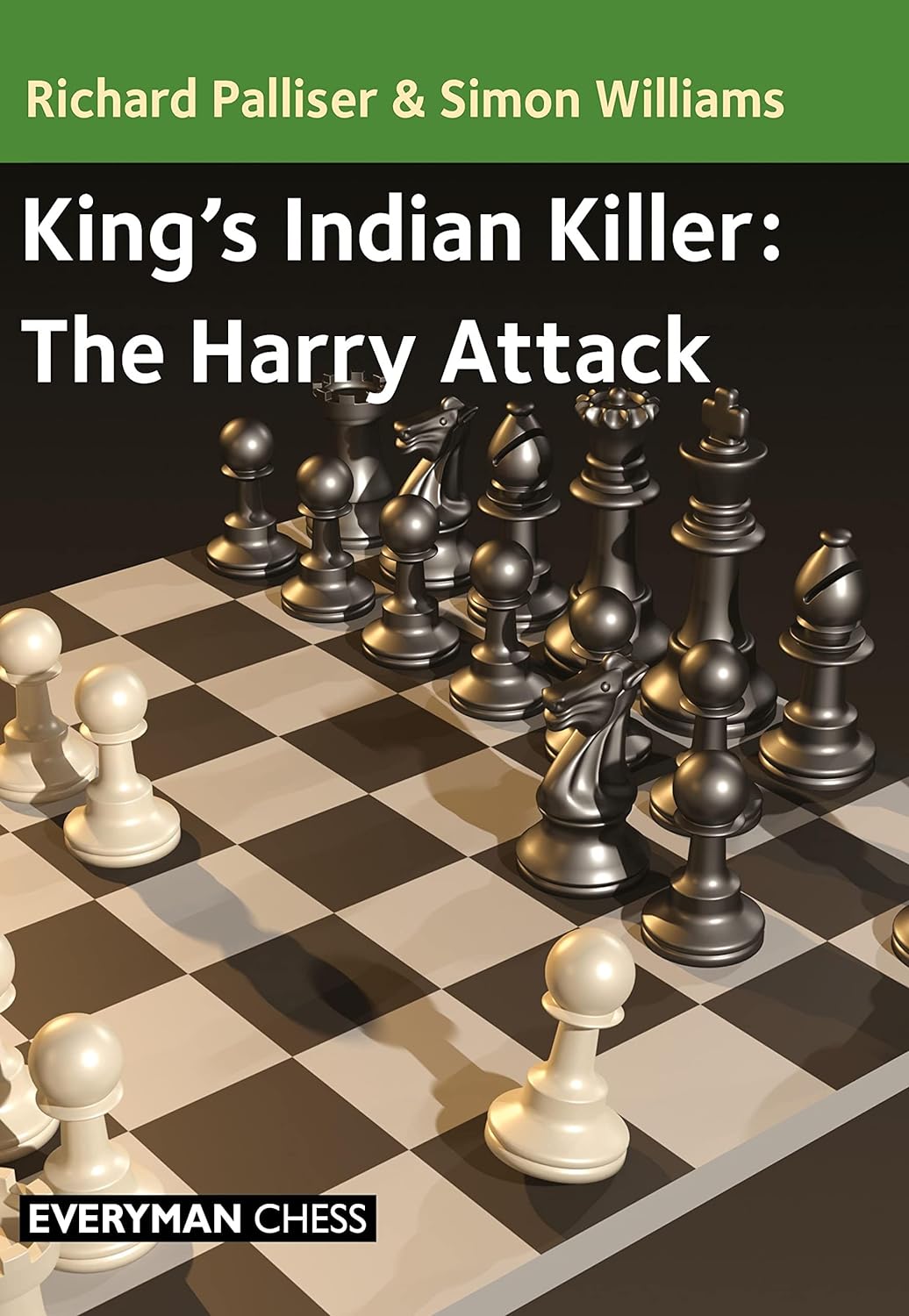King’s Indian Killer: The Harry Attack by Richard Palliser & Simon Williams
From the publisher, Everyman Chess:
“Do you want a simple and practical method to counter Black’s kingside fianchetto defences after 1 d4? A line that takes the initiative from a very early stage and creates difficult practical problems? If so, then The Harry Attack (1 d4 Nf6 2 c4 g6 3 h4!) is for you.
At first this looks like some sort of joke or, at the very least, a weird outlandish line. Aren’t we all taught to focus on development and control of the centre in the early stages? What’s 3 h4 got to do with that? Perhaps surprisingly, this is a very difficult line for Black to counter effectively. This applies not just in practical play but also theoretically, where it is far from straightforward for Black even to find a route to equality. And when Black gets it wrong they are often on the receiving end of a very unpleasant miniature.
You may be thinking that surely the best chess engines can show how to counter this line? No! One of the unexpected features of leading engine play is their enthusiasm for shoving the h-pawn up the board and they fully concur that 3 h4! is a very decent move for White.
Many leading players have taken the hint and 3 h4 is frequently seen at elite level. Richard Palliser and Simon Williams (the GingerGM) provide a thorough guide to this fascinating line. They show how to adapt when Black chooses a King’s Indian set-up, a Grunfeld set-up, a Benoni set-up or even plays in Benko style.
The Harry Attack is easy to learn and is perfect for unsettling players steeped in the theory of their favourite Indian defences.”
Simon Williams is a Grandmaster, a well-known presenter and a widely-followed streamer, as well as a popular writer whose previous books have received great praise. He is much admired for his dynamic and spontaneous attacking style.

Richard Palliser is an International Master and the editor of CHESS Magazine. In 2006 he became Joint British Rapidplay Champion and in 2019 finished third in the British Championship. He has established a reputation as a skilled chess writer and written many works for Everyman, including the bestselling The Complete Chess Workout.

Harry is a nickname for the h-pawn. The Harry Attack is 1.d4 Nf6 2.c4 g6 3.h4!?
Although this book is titled as an anti-King’s Indian system, it is also aimed at the Gruenfeld Defence as the book explains.
The reviewer likes the book and despite his initial scepticism about the Harry Attack (based on his ignorance), has come to realise that this is a serious system that cannot be refuted: in fact it has been adopted at the highest levels. It is not just a one trick pony with the crude idea of hacking down the h-file, it is a sophisticated scheme with many facets including space gain. After just one or two careless moves, black can easily find himself/herself being suffocated, devoid of counterplay.
Of course, it is an “anti-book/theory” system aimed at getting the opponent out of their familiar territory. As ever, these fresh systems soon acquire a fair body of theory!
This book is suitable for club players and above. Chapter 2 gives a pertinent precis of the whole system which would be perfectly adequate for a less experienced player to play the variation with confidence.
The book is divided into seven main chapters:
Chapter 1: Model Games
Chapter 2: The Basic Repertoire
Chapter 3: Gruenfeldesque Lines
Chapter 4: Black Obstructs Harry
Chapter 5: Other Third Move Alternatives to 3…Bg7
Chapter 6: King’s Indian Style 3…Bg7
Chapter 7: The Main Line: 3…Bg7 and 6…c5
Chapter 1: Model Games
This is a really good section that shows many of the key ideas of the Harry Attack. There are six model games that are definitely worth studying. A summary of these games is:
- Games 1, 2 & 3 show typical continuations if black replies with the Gruenfeld move d5 on moves 3 or 4
Chapter 3 covers this in more depth - Game 4 showcases black blocking Harry with 3…h5
Chapter 4 gives further coverage when black blocks Harry - Game 5 introduces the second player responding in a Modern Benoni fashion
Chapter 7 gives good guidance on this main line - Game 6 demonstrates Peter Svidler responding in Benko Gambit style
Chapter 7 also presents this important system in more detail
The first two games show black’s difficulties if he insists on playing a Gruenfeld setup. viz: 1.d4 Nf6 2.c4 g6 3.h4!? Bg7 4.Nc3 d5?!

Game 1 is a superb model game from the late and great Mike Basman.
After 5.h5! Nxh5 6.cxd5 c6 (6…e6 is a more modern try but white has powerful riposte with an excellent pawn sacrifice covered in Chapter 3. Buy the book to find out.) 7.e4! cxd5 8.e5! A well judged pawn sac’ from the creative Basman viz:

White has a simple threat of 9.g4 winning the stranded knight, after 8…Bf8 9.Nf3 Nc6 (9…Bg4 10.Qb3! is awkward) 10.Qb3! white has a clear advantage:

The next few moves showed what a pickle black is in 10…e6 11.g4! Ng7 12.Bh6! reaching this horror show for black:

The knight on g7 is particularly awkward. Basman went on to win a fine game.
The second illustrative game shows one of the authors, Simon Williams, in scintillating form beating Katarzyna Toma following the Mike Basman game until move 9, where black varied with 9…Ng7, white responded with the natural 10.Qb3!

Stockfish gives this as a clear plus to white. Simon went on to win a fine game.
Chapter 2: The Basic Repertoire
This section gives the reader a quick overview of the repertoire against black’s main tries. It is a useful introduction to all the subsequent chapters. As I stated above, this chapter is adequate coverage for a less experienced player to play this system.
Chapter 3: Gruenfeldesque Lines
As already mentioned, this covers black’s attempt at an early d5.
Stockfish does not like 4…d5 and gives 5.h5! with an edge for white already!

Black’s best move, according to the engine, appears to be the nonchalant 5…0-0 completely ignoring white’s attack! 6.hxg6 hxg6 7.cxd5 Nxd5 8.Bh6!

This is looks scary for black, but he can defend with 8…Bxh6! 9.Rxh6 Kg7! Nevertheless, white is still for choice here owing to his extra space, central control and the initiative. This is covered in some detail in Chapter 3.
Beware Gruenfeld players!
Chapter 4: Black Obstructs Harry
Black can block the h-pawn with 3…h6 or 3…h5 which is committal.
The obstructive 3…h5 can lead to either KID or Gruenfeld lines with the extra h4 and h5 moves thrown in. Who does this favour? White can profitably occupy g5 with a bishop or knight that cannot be kicked with h6. Buy the book to find out.
Chapter 5: Other Third Move Alternatives to 3…Bg7
This chapter important alternatives such as the super solid 3…c6 and the more aggressive 3…c5 which can lead to Benoni or Benko Gambit type positions.
The solid 3…c6 cannot be a bad move. White responds by going into a Schlechter Slav viz: 4.Nc3 d5 5.cxd5 cxd5 6.Bf4 Nc6 7.e3 Bg7 8.Be2 h5 9.Nf3 0-0 10.Qb3

White has a pull here and his position is easier to play. The line given in the book involves black playing a5 a few moves later which is a little compliant creating weaknesses.
After the Benko Gambit type response viz: 1.d4 Nf6 2.c4 g6 3.h4 c5 4.d5 b5!? 5.cxb5 a6 6.e3!

White plays solidly and intends to use b5 as an outpost to slow black’s counterplay. Clearly black has some compensation here but not a full pawn’s worth. A critical line here may be 6…Bg7 7.Nc3 0-0 8.a4! e6!? This is covered in the book.
Chapter 6: King’s Indian Style 3…Bg7
This and the final chapter are probably the key chapters for more experienced players who want to get to the meaty main lines.
Chapter 7: The Main Line: 3…Bg7 and 6…c5
After these natural moves 1.d4 Nf6 2.c4 g6 3.h4 Bg7 4.Nc3 d6 5.e4 0-0 6.Be2 c5 7.d5 e6 8.h5 exd5 9.exd5! Re8 10.h6! Bh8 11.Bg5, this tabiya is reached:

This is a hot position played quite a bit at the top level. The open e-file may look scary for white, but the king can slide to f1. White’s space advantage is significant and black can have difficulties finding counterplay. Stockfish gives white about a small advantage. More important than that is understanding the ideas in this interesting position. Get the book to further your knowledge.
For those competitors fed up with meeting reams of KID or Gruenfeld theory, I recommend giving The Harry Attack a go!
FM Richard Webb, Chineham, Hampshire, 9th June 2024

Book Details :
- Paperback: 400 pages
- Publisher: Everyman Chess (12 Jun. 2023)
- Language: English
- ISBN-10: 1781947066
- ISBN-13: 978-1781947067
- Product Dimensions: 17.17 x 1.4 x 23.39 cm
Official web site of Everyman Chess


